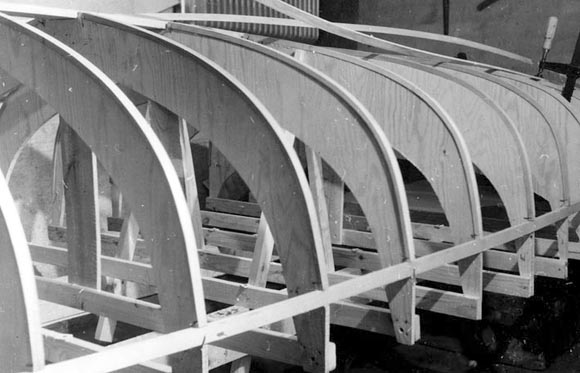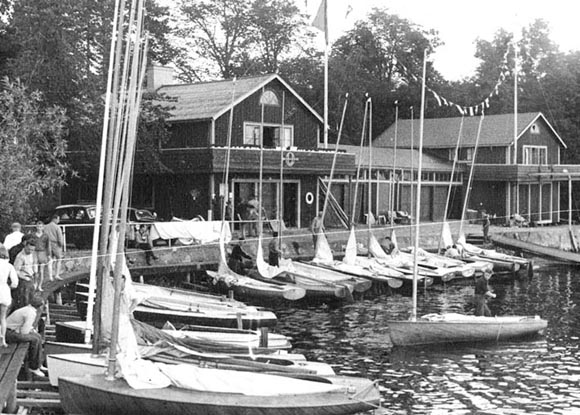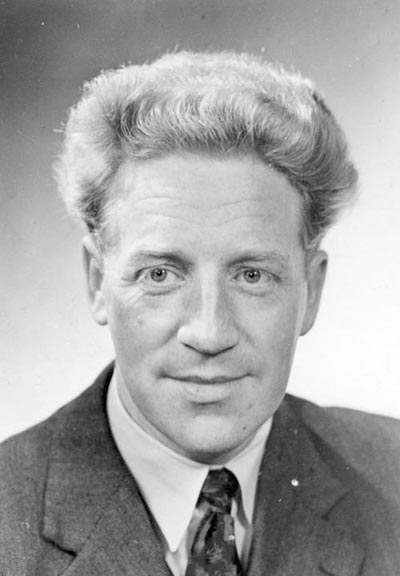That attempt was of course successful and the class has grown since then to be one of the most successful and famous sailing dinghies of all time. This weekend in Uppsala the class will celebrate 60 years of Finn sailing at an event that is one of the highlights of the circuit in 2009. For many sailors a trip to Uppsala Kanotförening (Uppsala Canoe Club) is a kind of pilgrimage, going back to the birthplace of the class.

Above: Building Finn No. 1 in 1949
The club in Uppsala still has a strong Finn fleet and built its reputation on the traditional sailing canoes found in Sweden and almost nowhere else. Sarby was already an expert in designing and sailing these craft when he penned the lines for the Finn. In fact the Finn's design follows many of the principles of the sailing canoe, although these were double ended. In crude terms the Finn was basically a double-ended canoe with the aft section sheared off to make a transom. And of course with only one mast.

Above: Uppsala Kanotforening in 1956
Designer
Rickard Sarby was man of few words, so very little is documented about him before the Finn came along, but he was a fascinating person, multi-talented and self-educated with extraordinary gifts and creativity. He was born in 1912 in a small village called Pesarby, which is about 50km north of Uppsala (which is 70km north-west of Stockholm). The name of the village actually gave rise to the family name. He was the youngest of four brothers and one sister. His only formal education were the six years he spent at Swedish elementary school.
 Left: Rickard Sarby
Left: Rickard Sarby
But Rickard came from a very talented and creative family, each one being artistic or musical in some way. When the family moved to Uppsala in the 1930s, Rickard was educated as a barber. For many years he ran one of the biggest barbershops in Uppsala, which became famous because of its imaginative and prize-winning Christmas window displays.
Soon after arriving in Uppsala, Rickard was also introduced to canoe sailing and skate sailing by his oldest brother Ernst, who was an enthusiast and a driving force of Uppsala Kanotförening.
Uppsala Kanotförening was founded in 1916 as a sport club for elite canoe paddling by a young engineer Sven Thorell, who would later become one of Sarby's main opponents in the design competition for the 1952 Olympics. The club house is situated 9km south of Uppsala on the shores of Lake Ekoln, the northern part of Lake Mälaren, an ideal area for small boat sailing and racing.
The club became a unique breeding ground for small boat sailing, as well as skate sailing, and it was in this environment that Rickard was in his
element, designing and racing sailing canoes. He was an innovator in boat and sail building techniques including producing laminated waterproof paper sails at a time after World War II when sail cloth was hard to obtain. He also designed the original flap bailer that was later commercialised as the 'Elvstrøm' bailer.
All this experience came to a head in the Finn. His approach was to sketch full size drawings while also building scale models. The first Finn was built in double diagonal planking, which proved to be fast, and suitable for amateur building, but later, boats were also built from baking layers of veneer strips over a shell, and he also built some fibreglass hulls.
Sarby's legacy cannot be overstated. His design was so perfect that it has remained at the forefront of international and Olympic competition for six decades, while undergoing a continuous development in rules and technology. However, the hull shape, developed from the Swedish sailing canoes, and controlled by a strict set of class rules, remains untouched to this day.
Celebration
Combined with the Swedish Nationals, the event this coming weekend has drawn 79 pre-entries from 11 nations, for what will be the largest Finn event in Sweden for 18 years. It will be both a celebration of the Finn and the man who brought it into existence. No story of the Finn is complete without mention of its father, who put considerable effort into the class in the years following the initial design.
Rickard Sarby died in 1977, but his nephew Bert Sarby, and the original owner of Finn No 2 is expected to put in an appearance over the weekend in Uppsala, along with the original Finn No.1, preserved and looked after by the local maritime museum.
Nine races are scheduled from Friday 14 to Sunday 16 August with, of course, the usual Finn dinner and parties, held in conjunction with the Ekolns Segelklubb, the neighbouring club which is co-hosting the Swedish Championship for the Two-Crown class as part of the weekend.































































